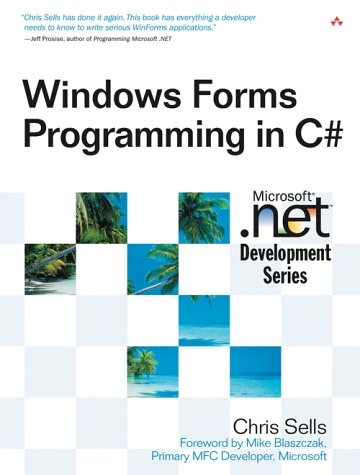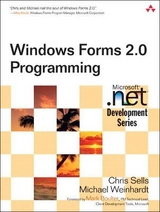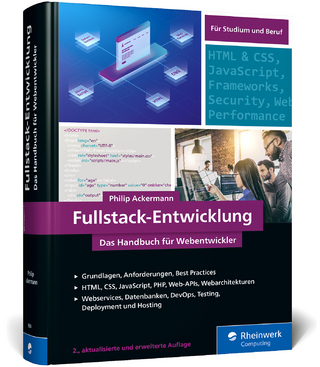
Windows Forms Programming in C#
Addison-Wesley Educational Publishers Inc (Verlag)
978-0-321-11620-8 (ISBN)
- Titel erscheint in neuer Auflage
- Artikel merken
Much of the publicity around .NET has focused on using .NET to build Webbased applications. Many developers, however, are using .NET to build traditional Windows-based applications. Microsoft has provided a package called Windows Forms, or WinForms, which makes the development of these apps easier and faster than ever. Chris Sells has written the definitive book to help experienced Microsoft developers master the use of this powerful toolkit.
Based on the experience he has gained developing with and teaching WinForms for the last two years, he goes beyond other books currently on the market. Chris has a critically acclaimed writing style that allows him to keep the material concise and easy to follow. He concentrates on what you won't find in the documentation, giving developers the information they really need.
Reviewers are already calling this "the best WinForms book around", "the definitive book for every Windows Programmer", and "without a doubt the best and most useful C#/WinFOrms book I have ever read." We will be publishing a Visual Basic .NET version later this year.
Chris Sells is a content strategist on the Microsoft MSDN content team. Previously, he was the director of software engineering at DevelopMentor. Chris is the author of Windows Telephony Programming (Addison-Wesley, 1998) and Windows Forms Programming in Visual Basic .NET (Addison-Wesley, 2004), and coauthor of Effective COM (Addison-Wesley, 1999), ATL Internals (Addison-Wesley, 1999), and Essential .NET, Volume 1 (Addison-Wesley, 2003). 0321116208AB07142003
Figures.
Tables.
Foreword.
Preface.
1. Hello, Windows Forms.
WinForms from Scratch.
Windows Forms in Visual Studio .NET.
Arranging Controls.
Controls.
Application Settings.
Resources.
Dialogs.
Drawing and Printing.
Data Binding.
Multithreaded User Interfaces.
Deployment.
Moving from MFC.
Where Are We?
2. Forms.
Showing Forms.
Owner and Owned Forms.
Form Lifetime.
Form Size and Location.
Restricting Form Size.
Z-Order.
Form Adornments.
Form Transparency.
Nonrectangular Forms.
Form Menus.
Context Menus.
Child Controls.
Control Z-Order.
Control Tab Order.
Themed Controls.
Hosting COM Controls.
Layout.
Form Auto-Scaling.
Anchoring.
Docking.
Docking and Z-Order.
Splitting.
Grouping.
Custom Layout.
Multiple Document Interface.
Menu Merging.
Visual Inheritance.
Where Are We?
3. Dialogs.
Standard Dialogs.
Styles.
Setting Modal Versus Modeless Behavior Dynamically.
Data Exchange.
Handling OK and Cancel.
Modeless Form Data.
Data Validation.
Regular Expressions and Validation.
Data Format Notification.
Thorough Validation.
Implementing Help.
Tooltips.
Using the ErrorProvider for General Information.
Handling the Help Button and F1.
Using HTML Help.
Compiled HTML Help.
Using the HelpProvider Component.
Showing Help Contents, Index, and Search.
Where Are We?
4. Drawing Basics.
Drawing to the Screen.
Handling the Paint Event.
Triggering the Paint Event.
Colors.
Known Colors.
Color Translation.
Brushes.
Solid Brushes.
Texture Brushes.
Hatch Brushes.
Linear Gradient Brushes.
Path Gradient Brushes.
Pens.
Line Caps.
Dashes.
Alignments.
Joins.
Creating Pens from Brushes.
Shapes.
Curves.
Smoothing Modes.
Saving and Restoring Graphics Settings.
Paths.
Fill Modes.
Images.
Loading and Drawing Images.
Scaling, Clipping, Panning, and Skewing.
Rotating and Flipping.
Recoloring.
Transparency.
Animation.
Drawing to Images.
Icons.
Cursors.
Where Are We?
5. Drawing Text.
Fonts.
Creating Fonts.
Font Families.
Font Characteristics.
Font Height.
Strings.
Formatting.
Strings and Paths.
Where Are We?
6. Advanced Drawing.
Page Units.
Converting Pixels to Page Units.
Transforms.
Scaling.
Scaling Fonts.
Rotation.
Translation.
Shearing.
Combining Transforms.
Transformation Helpers.
Path Transformations.
Regions.
Constructing and Filling a Region.
Clipping to a Region.
Region Combination Operations.
Optimized Drawing.
Double Buffering.
Other Drawing Options.
Where Are We?
7. Printing.
Print Documents.
Print Controllers.
Print Preview.
Basic Print Events.
Margins.
Page Settings.
Printer Settings.
Print Range.
Targeting the Printer.
Where Are We?
8. Controls.
Standard Controls.
Action Controls.
Value Controls.
List Controls.
Container Controls.
ImageLists.
Owner-Draw Controls.
Custom Controls.
Deriving Directly from the Control Class.
Testing Custom Controls.
Control Rendering.
Ambient Properties.
Custom Functionality.
Control Input.
Windows Message Handling.
Scrolling Controls.
Extending Existing Controls.
User Controls.
Drag and Drop.
The Drop Target.
The Drop Source.
Where Are We?
9. Design-Time Integration.
Components.
Standard Components.
Custom Components.
Design-Time Integration Basics.
Hosts, Containers, and Sites.
Debugging Design-Time Functionality.
The DesignMode Property.
Attributes.
Property Browser Integration.
Code Serialization.
Batch Initialization.
Extender Property Providers.
Type Converters.
Expandable Object Converter.
UI Type Editors.
Drop-Down UI Type Editors.
Modal UI Type Editors.
Custom Designers.
Design-Time-Only Properties.
Design-Time Context Menu Verbs.
Where Are We?
10. Resources.
Resource Basics.
Manifest Resources.
Typed Resources.
Resource Manager.
Designer Resources.
Resource Localization.
Culture Information.
Resource Probing.
Resource Localization.
Resource Localization for Nondevelopers.
Resource Resolution.
Input Language.
Where Are We?
11. Applications and Settings.
Applications.
Application Lifetime.
Application Context.
Application Events.
UI Thread Exceptions.
Single-Instance Applications.
Passing Command Line Arguments.
Multi-SDI Applications.
Environment.
Compile-Time Settings.
Environment Settings.
Settings.
Types of Settings.
.config Files.
Dynamic Properties.
The Registry.
Special Folders.
Settings and Streams.
Isolated Storage.
Versioned Data Paths.
Choosing a Settings Mechanism.
Where Are We?
12. Data Sets and Designer Support.
Data Sets.
Retrieving Data.
Creating Data.
Updating Data.
Deleting Data.
Tracking Changes.
Committing Changes.
Multitable Data Sets.
Constraints
Relations.
Navigation.
Expressions.
Designer Support.
Connection Objects.
Command Objects.
Data Adapter Objects.
Typed Data Sets.
Creating a Typed Data Set.
Constraints in Typed Data Sets.
Relations in Typed Data Sets.
Expressions in Typed Data Sets.
Adding a Typed Data Set to a Form.
Where Are We?
13. Data Binding and Data Grids.
Data Binding.
Bindings and Data Sources.
Simple Data Binding to Items.
Simple Data Binding to Lists
Simple Binding to Data Sets.
Binding Managers.
Current Data Row.
Changes to the Data Set.
Changes to the Control.
Complex Data Binding.
Data Views.
Master-Detail Relations.
Data Grids.
Formatting Data Grids.
Data Exchange and Data Grids.
Bringing It All Together.
Custom Data Sources.
Custom Item Data Sources.
Type Descriptors and Data Binding.
Type Conversion.
List Data Sources.
Where Are We?
14. Multithreaded User Interfaces.
Long-Running Operations.
Progress Indication.
Asynchronous Operations.
Safety and Multithreading.
Simplified Multithreading.
Canceling.
Communication with Shared Data.
Communicating via Method Parameters.
Communication via Message Passing.
Asynchronous Web Services.
Where Are We?
15. Web Deployment.
Hosting Controls in Internet Explorer.
Control Creation.
Control Interaction.
Code Access Security.
Checking for Permissions.
Awarding Permissions.
No-Touch Deployment.
Application Download.
Versioning.
Related Files.
Partially Trusted Assembly Considerations.
Allowing Partially Trusted Callers.
Settings.
Custom User Input.
Communicating via Web Services.
Reading and Writing Files.
Command Line Arguments.
Debugging NTD Applications.
Increasing Permissions.
Increasing Permissions Programmatically.
Deploying Permissions.
Authenticode.
Where Are We?
A. Moving from MFC.
A Few Words About MFC.
MFC Versus WinForms.
The Differences.
Strategy.
Genghis.
B. Delegates and Events.
Delegates.
Events.
Harvesting All Results.
Asynchronous Notification: Fire and Forget.
Happiness in the Universe.
C. Serialization Basics.
Streams.
Formatters.
Skipping a Nonserialized Field.
IDeserializationCallback.
ISerializable.
Data Versioning.
D. Standard WinForms Components and Controls.
Components and Controls Defined.
Standard Components.
Standard Dialogs.
Notify Icons.
Timer.
Image List.
Main Menus and Context Menus.
Standard Controls.
Non-Container Controls.
Container Controls.
Bibliography.
Index. 0321116208T08272003
| Erscheint lt. Verlag | 4.9.2003 |
|---|---|
| Verlagsort | New Jersey |
| Sprache | englisch |
| Maße | 175 x 229 mm |
| Gewicht | 1120 g |
| Themenwelt | Mathematik / Informatik ► Informatik ► Programmiersprachen / -werkzeuge |
| ISBN-10 | 0-321-11620-8 / 0321116208 |
| ISBN-13 | 978-0-321-11620-8 / 9780321116208 |
| Zustand | Neuware |
| Haben Sie eine Frage zum Produkt? |
aus dem Bereich



